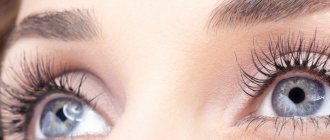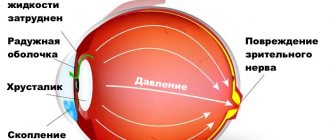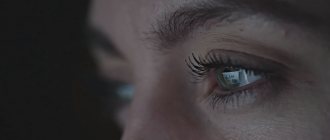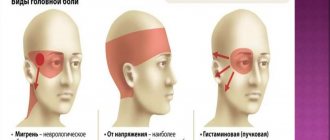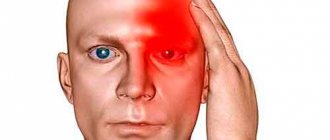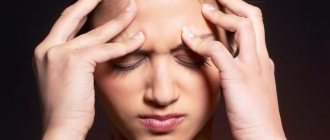Patients often complain that the bridge of their nose hurts, sometimes for no apparent reason. If a person experiences pain in the forehead or eyes, these signs may indicate the presence of one of several pathologies.
To find out how to get rid of pain in the frontal part of the head, it is recommended to undergo diagnostics. Treatment prescribed by a specialist will help you get rid of the disease.
To understand exactly what diseases cause discomfort in the bridge of the nose, we will determine the main causes of pain and methods of treating them.
Causes of pain in the bridge of the nose and forehead
Pain is a symptom of many diseases. If it is localized in a certain place, this indicates that this particular part of the patient’s body is affected.
Headaches appear due to disturbances in the functioning of the nervous and cardiovascular systems of the body, diseases of the ENT organs, teeth, and so on.
When the bridge of the nose and forehead hurt, the doctor first of all looks for the cause in damage to nearby organs and blood vessels. Let's look at the most common causes and nature of pain.
Neuralgia
A fairly harmless etiology of pain in the forehead and bridge of the nose is neuralgia of the nasociliary nerve. Patients under 35-40 years of age are most susceptible to this pathology. A person feels discomfort, pain in the sinuses, forehead, eyes.
Nature of pain:
- quite strong, and when acutely manifested, can cause night awakenings. They often appear at night;
- pressing, with this pathology the pain presses on the bridge of the nose, forehead, and there is a feeling of fullness from inside the head.
Additional symptoms:
- the pathology affects the eyes: they may turn red, lacrimation appears, and sometimes the nutrition of the cornea is disrupted;
- pulsation in the frontal region;
- Nasal discharge appears, the nasal mucosa swells, and turns red.
Complications of acute respiratory infections, dental ailments, ENT diseases affecting nerve endings, including a deviated nasal septum, and other causes can lead to this pathology.
Injuries to the bridge of the nose
In patients of all ages, headaches in the bridge of the nose are caused by injuries. A blow to the nose can be caused by an unsuccessful fall, attack, or active children's games. The consequences of injuries are soft tissue bruises, cartilage damage, swelling and redness in the affected area, and abrasions.
If a nasal fracture occurs, this is a reason to immediately contact an otolaryngologist. Restoring the nasal septum and the patency of the nasal passages will relieve the patient of discomfort and pain.
Acute sinusitis
With sinusitis, the patient suffers from severe pain, which is especially intense in the morning or evening. This disease can be suspected when pain radiates to the bridge of the nose when turning the head, touching the skin of the face, and discomfort is felt in the area of the eye sockets and forehead.
Chronic pathologies of ENT organs
Periodically occurring runny nose, swelling and nasal congestion indicate the presence of a focus of inflammation in one of the ENT organs. Chronic pathologies are diagnosed quite often.
The first sign of an inflammatory process in the ENT organs, which occurs in a chronic form, is a headache.
It is accompanied by general weakness and tingling in the bridge of the nose. With provoking factors, the disease worsens. These factors are:
- severe physical fatigue of the patient;
- decreased immunity;
- overheat.
Rhinitis
Acute rhinitis is also sometimes accompanied by bursting, pressing pain in the nose. With this pathology, a discharge of watery mucus appears, acquiring a thick consistency over time.
Swelling appears, and a focus of infection appears in the nasal cavity. In the absence of adequate treatment, rhinitis can become complicated or become chronic.
Sinusitis
When acute sinusitis does not go away within a week, it can be assumed that the inflammation has spread to the maxillary sinuses - sinusitis develops.
This pathology requires immediate intervention by an otolaryngologist, as it can lead to serious consequences. With sinusitis, the patient feels a severe headache, pulsation, which sometimes radiates to the temple area.
The symptom complex is also complemented by pain in the forehead and bridge of the nose; there may be no exudate in the first days. Then the patient notes the release of yellow thick mucus and an increase in temperature. Some people experience migraines; intoxication of the body is externally manifested in general weakness and increased fatigue.
Frontit
This is an inflammation of the frontal sinuses - the frontal sinuses. The pathology manifests itself as pain in the forehead, the area between the eyebrows, and the bridge of the nose. When a person tilts his head, mechanical pressure occurs on the inflamed area, and the pain will intensify. The pathology is accompanied by a feeling of heaviness in the area of inflammation.
Ganglionitis
The disease occurs due to inflammation of the pterygopalatine nerve ganglion. Signs indicating the presence of this pathology:
- severe pain in the bridge of the nose, forehead;
- dizziness, cephalgia;
- eye sockets hurt;
- the pain intensifies if you press in the area of the eye sockets.
Unpleasant sensations also radiate to different areas of the head, especially to the upper jaw, rarely to the shoulders and shoulder blades.
Ethmoiditis
Features of the pathology are severe headache, nasal congestion, a feeling of fullness in the bridge of the nose, impaired sense of smell, and low-grade fever. Pathology occurs as a complication of a runny nose, inflammation of the frontal and maxillary sinuses. The causative agent is a viral or bacterial infection.
Treatment
Treatment for the condition is aimed at eliminating the root cause. Neurological disorders are treated only in a hospital setting, since in such situations there is a high risk of complications.
If the cause of pain in the bridge of the nose is respiratory infections, leading to the development of sinusitis, rhinitis, sinusitis or sinusitis, treatment is carried out using dosage forms and physiotherapy. When a problem arises due to injury, surgery is often prescribed to restore the normal state of the nasal septum.
Medicines
Drug therapy is prescribed after diagnosis and results are obtained. The patient is prescribed medications that eliminate the inflammatory process and restore breathing. The treatment regimen is developed taking into account the type of pathogen; these can be antiviral or antibacterial agents.
In addition, patients use symptomatic medications:
- antihistamines;
- mucolytic;
- vasoconstrictors;
- corticosteroids;
- antipyretics;
- analgesics.
To speed up the healing process, inhalations using compressor or ultrasonic inhalers may additionally be prescribed.
The treatment regimen is developed strictly by the attending physician based on the diagnostic results and the existing clinical picture. With timely treatment, inflammatory processes in the nose can be eliminated in two weeks.
Therapy includes two stages:
- elimination of the pathogen (taking antibacterial or antiviral drugs);
- elimination of residual symptoms (use of symptomatic medications).
Presumable treatment regimen for inflammatory processes of the upper respiratory tract:
| Dosage form | Action | Name of drugs |
| Antibacterial agents | They have a detrimental effect on pathogenic microflora, while destroying healthy ones, and eliminate purulent lesions. |
|
| Antimicrobial (nasal) agents | Reduce swelling and eliminate the inflammatory process in the paranasal sinuses. |
|
| Vasoconstrictor drugs | Reduce swelling, stimulate the outflow of escudate. |
|
| Mucolytic drugs | They liquefy mucous accumulations in the nose and speed up the process of their removal. |
|
| Moisturizing nasal drops | Moisturize the nasal mucosa and stimulate the local immune response. |
|
| Antihistamines | They reduce swelling, relieve unpleasant symptoms of itching and burning, and eliminate inflammation. |
|
The dosage of dosage forms is determined by the attending physician; self-medication in such situations can lead to the most severe consequences. Severe forms of inflammation of the nasal mucosa can only be cured in a hospital setting under the watchful supervision of medical personnel.
For sinusitis, surgical treatment is often prescribed, which involves puncturing the inflamed areas. To prevent relapses, patients are prescribed a vitamin-mineral complex, and when the first alarming symptoms appear, treatment is started immediately.
Physiotherapy
Diseases that cause pain in the bridge of the nose are treated comprehensively using certain groups of pharmacological drugs and physiotherapy. Physiotherapy is aimed at cleansing the paranasal sinuses from accumulated escudant and pathogenic microorganisms. The method is very effective in the development of chronic inflammatory process in the upper parts of the respiratory system.
Physiotherapy includes:
- electrophoresis;
- phonophoresis;
- UHF therapy.
An appointment for procedures can only be issued by the attending physician based on the results of diagnosis and monitoring of the course of the disease, since such tactics at a certain stage can cause hyperthermia. As a result, the patient has a risk of relapse, development of purulent inflammation and deterioration in general well-being.
Massage
The technique of acupressure has long established itself as an effective remedy for inflammation and nasal congestion. Before you start the procedure, you need to know that it is not allowed for all pathologies. Massage can be performed only if you have a runny nose without fever and if you are sure there is no injury. Before performing this, you must consult a doctor.
The massage is done with clean, warm hands. Rotational movements of the fingers are carried out in one direction, then in the other, 20-30 times. They start the technique from certain points, gradually replacing them with others.
Alternate massage places:
- deepening of the wings of the nose;
- the points under the nostrils where the lips and nose connect;
- tip of the nose;
- between the eyebrows;
- at the temples.
In addition to the indicated points, the area on the hands between the thumb and forefinger is massaged. The points activate blood circulation and restore tissue activity.
Surgical intervention
Surgical treatment is prescribed only if conservative methods are not effective. The purpose of the operations is to cleanse the nasal passages of purulent escudant and pathogenic microorganisms, restoring the normal state of the nasal septum.
Methods of surgical treatment of nasal passages from purulent contents:
| Method | Description of the procedure |
| Using Kasirsky's needle | A puncture is made in the frontal lobe, through which the pathogenic escudent is removed. |
| Using a video endoscopic device | The paranasal sinuses expand, which improves the removal of purulent fluid from the area of inflammation. |
Surgical treatment tactics are prescribed only if there is a risk of developing intracranial inflammation.
The main reason that, without injury, the bridge of the nose may hurt when pressed is inflammation of the paranasal sinuses, which in turn is caused by an infection, allergy or neurological disorders.
It must be said that even a common runny nose without adequate treatment can provoke the development of sinusitis. It is dangerous to ignore the symptom of pain in the bridge of the nose. The neglect of the process can threaten the spread of inflammation to soft and bone tissues with further damage to brain structures.
When a doctor's help is needed
Due to certain circumstances, adults tend to delay visiting a doctor. Self-medication methods are often used that do not give positive results. Patients do not suspect that if the bridge of the nose and head constantly hurt, this can lead to disastrous consequences.
Symptoms that require immediate medical attention:
- hyperthermia – an increase in temperature to 38 degrees or higher, which lasts more than 3 days;
- My head hurts constantly and never stops.
- the forehead hurts so much that it is difficult for a person to bend over, turn his head, sleep, and the feeling of heaviness in the head does not go away;
- the appearance of rashes on the body;
- purulent exudate flows from the nose;
- dizziness, nausea or vomiting that lasts for several days.
Pain that does not go away for several days is already a reason to visit a neurologist or otolaryngologist. If a person experiences several of the above symptoms at the same time, it is necessary to immediately consult a doctor. Without exaggeration, the patient’s full life is at stake.
Diagnostics
Diagnostic measures depend on the nature of the symptoms. With a correct diagnosis, it is easy to cure a protracted disease that causes pain in the bridge of the nose. To differentiate a neurological or otolaryngological diagnosis, an examination is carried out, during which the following methods are used:
- general blood and urine tests - allow you to identify disturbances in the functioning of the body, the presence of inflammatory processes, viral or bacterial infections;
- nasal swab for bacterial culture - necessary to determine the type of pathogen;
- X-ray of the nasal cavity - allows you to identify damage to the nasal bones or the presence of exudate in the nasal sinuses;
- Ultrasound of the sinuses;
- Magnetic resonance imaging of the head is a very informative method for identifying changes in tissues and organs when they are damaged.
For pain in the forehead, making a diagnosis is extremely important, since the inflammatory process under certain conditions can quickly spread to other tissues, even to the membranes of the brain. It is possible that during diagnostic measures the patient will need additional consultation with a surgeon, neurologist, or dentist.
What to do?
If your forehead hurts and puts pressure on your eyes, you need to open a window for fresh air and try to make rotational movements with your head. If this leads to increased discomfort, then there is a high probability of developing cervicalgia (headache associated with spasm of the spinal canal). This is the so-called muscle tension headache. It occurs in people whose work involves prolonged static tension in the muscles of the neck and collar area. By the end of the working day, they have a headache in the forehead and pressure on the eyes due to the fact that the muscles in static tension disrupt the blood flow through the arteries that ensure the flow of arterial blood to the cerebral structures.
What to do in this situation? First of all, it is necessary to ensure the presence of a constant flow of fresh air into the room where the person is chatting. Next, you need to introduce mandatory physical exercises into your daily routine aimed at relaxing the neck muscles. Well, you need to visit a vertebrologist to rule out degenerative destruction of the intervertebral discs in the cervical spine and posterior vertebral artery syndrome.
The second common situation is an increase in blood pressure. Both very young and elderly people can suffer from this unpleasant symptomatic phenomenon. In youth, blood pressure increases due to unstable functioning of the autonomic nervous system.
Treatment for pain in the forehead and bridge of the nose
During the examination, the condition of the sinuses is determined, whether there are neoplasms or chronic foci of infection there. Pain in the bridge of the nose is also possible with congenital pathology of the ENT organs; in this case, only surgical treatment is indicated - surgery.
When pain is accompanied by a runny nose, rinsing the nasal passages is a harmless treatment at home. This is first aid for acute sinusitis and rhinitis. To do this, you need to arm yourself with a bulb or syringe.
A special solution is poured into one nasal passage and removed through the second nostril or through the mouth. Then another move is washed. Nasal rinses are effective for sinusitis. Blowing your nose and irrigating with a saline solution does not fully guarantee the release of the purulent contents of the maxillary sinuses. The following tools are used for this procedure:
- potassium permanganate (potassium permanganate). The substance is completely soluble in water; in strong concentrations it can burn the mucous membrane.
- furatsilin;
- salt, preferably special sea salt. It copes well with removing pathological microorganisms and reduces swelling.
- chamomile decoction. Chamomile has antiseptic, anti-inflammatory properties;
- propolis tincture. Has antimicrobial and anti-inflammatory properties. Helps cope with infection, restores the normal state of the mucous membrane.
Various reasons lead to a feeling of fullness and pressure in the bridge of the nose; vasoconstrictor drugs are often used to relieve the symptom. Treatment of infection sometimes requires the use of strong antibiotics and corticosteroid drugs to reduce swelling and restore normal organ function.
Prevention
You can prevent the development of pathologies of the ENT organs and neuralgia by following simple rules:
- Avoid hypothermia and avoid contracting a viral or bacterial infection. A common cold, if not treated in a timely manner, if it is not treated correctly and if complications develop, can cause pain in the bridge of the nose.
- Take care to increase immunity. To achieve this, it is useful to harden the body, especially in childhood.
- Lead an active lifestyle - you need to do exercises and play sports. General strengthening physical exercises are suitable.
- To take care of your health, during the cold season you need to monitor the level of air humidity in the heated room. In hot weather, it is better to do wet cleaning in the house more often to reduce the entry of dust into the respiratory system. Dust settles on the mucous membrane of the nasal cavity, which makes it difficult for the important organ to function properly.
You can prevent headaches in the bridge of the nose and forehead by constantly strengthening the body. Summer is a great time for this. Eating seasonal vegetables and fruits and swimming in cool water help to naturally strengthen the body's defenses.
How to help yourself at home
When signs of pathology appear, it is necessary to strengthen the immune system and activate the body's reserve forces. To do this you need:
- ventilate the room at least twice a day;
- wipe dust more often;
- stay in bed for several days;
- take vitamin complexes and immunostimulants;
- limit contact with other people during therapy.
If rhinitis and headaches are present for a long time, you should not abandon the use of antipyretic drugs and analgesics. It is also recommended to take combination medications for influenza and ARVI.
To eliminate severe inflammation, apply a cold compress to your forehead. You can also take hot tea with lemon and raspberries. It is very useful to drink milk with honey.
How to relieve a headache in one minute:
What can cause pain in the bridge of the nose and head?
Soreness in the area of the bridge of the nose due to cephalgia in 90% of cases occurs as a result of a runny nose. Swelling of the nasal mucosa leads to an increase in its volume, blocking the normal flow of air. This provokes oxygen starvation of the brain, which manifests itself as pain in the head. The situation is aggravated by the presence of an inflammatory process and intoxication of the body.
If the bridge of your nose and forehead hurt, but there is no runny nose, this may be a sign of:
- wearing uncomfortable glasses – unsuitable lenses force a person to strain their eyes. A frame that is too tight disrupts the blood flow in the bridge of the nose;
- dermatological problems - a pimple, a wen, an inflamed comedon in the area between the eyebrows can cause discomfort and even an increase in body temperature;
- eye fatigue – prolonged work at the computer, reading in unfavorable conditions, passion for gadgets creates excessive stress on the oculomotor muscles;
- herpes - a viral pathogen, parasitizing the nasal mucosa, can cause cephalalgia and pain between the eyebrows;
- complications of injury - symptoms may appear immediately after the impact due to damage to soft tissues or take a delayed form. Sometimes the signs turn out to be a consequence of improperly fused bones or a deviated nasal septum.
The listed problems can manifest themselves exclusively as pain in the head and between the eyebrows, which complicates the diagnosis. If you experience any unpleasant sensations, you should not act on your own. It is better to immediately seek help from a professional to prevent the situation from worsening.
Flu
A viral infection becomes the result of the activity of an aggressive pathogen. The sooner specialized treatment is started, the lower the risk of complications. The pathology develops quickly, clearly manifests itself, and is difficult to ignore. In this case, cephalalgia is initially localized in the area of the bridge of the nose and forehead, gradually affecting the entire cranium. It becomes the body’s reaction to the release of toxins by the virus and tissue dehydration.
Signs that will help you recognize the flu:
- a sharp jump in body temperature to 38-40°C;
- joint pain, muscle aches, deterioration in general condition;
- headache is obsessive, intense, radiates to the eyes, practically does not respond to taking analgesics;
- nasal congestion, discharge of clear mucus from it at the initial stage;
- cough appears on the second day.
Therapy should be aimed at eliminating the pathogen. If you start taking antiviral drugs in time, relief will come in 2-3 days. Additionally, the body is combating dehydration with temperatures exceeding 38.5°C. The patient's immunity is strengthened with the help of vitamins, natural or chemical biostimulants.
Swelling of the nasopharynx
An increase in the volume of the nasal mucosa can occur in response to its irritation by mechanical particles, allergens, pathogens, or an increase or decrease in ambient temperature. The patient feels a bursting sensation in the nasopharynx, but his forehead does not necessarily hurt. Often the discomfort is concentrated in the back of the head. Treatment is selected depending on the causes of the problem. This may be the local use of vasoconstrictor drugs, rinsing the nasal passages with saline or an antiseptic, or taking antihistamines.
Otitis
Inflammation of the hearing organ is often accompanied by a headache. The sensations are sharp, shooting, radiating to the temple, forehead, bridge of the nose on one side.
Sometimes a runny nose occurs against this background. The disease itself is characterized by discomfort in the affected ear, decreased functionality, and discharge from the ear canal. Depending on the degree of damage to the organ, body temperature may rise and signs of intoxication of the body may appear. The diagnosis is made by an ENT specialist, who also selects a treatment regimen. Most often it is based on taking antibiotics, local treatment of the problem area, and symptomatic therapy.
Sinusitis
In people who neglect the treatment of colds, ARVI or flu, pain in the bridge of the nose is often a sign of damage to the paranasal sinuses. Inflammation of the cavities in the texture of the skull becomes a consequence of disruption of the outflow of mucus from the nose, the transfer of pathogens to nearby tissues, and filling of the voids with pus. At the same time, the clinical picture intensifies, all symptoms worsen. The patient is rapidly getting worse, traditional methods of therapy and self-selected medications no longer bring relief.
Headache and runny nose: what happens in the body
The appearance of headaches due to rhinitis and colds is due to a number of reasons. The main factor is considered to be an increase in the production of intracranial fluid. It compresses the membranes of the brain. This is often associated with an increase in temperature.
Another factor is intoxication of the body due to the activity of pathogenic microorganisms. Also, the reason may lie in inflammation of the paranasal sinuses or the development of otitis media.
Headaches that occur against the background of a runny nose are usually characterized by aches, a feeling of heat, and chills. If the cause of symptoms is influenza, the pain syndrome is much more pronounced. It affects the frontal areas, temples, eyebrows, and eye area.
Diagnostic features
If there is discomfort in the bridge of the nose, it is better not to delay a visit to a specialist. In the absence of accompanying symptoms, you can try to relieve cephalalgia using traditional methods. Against the backdrop of a clear clinical picture, it is recommended to go to a therapist or ENT specialist. It is mandatory to take a general blood and urine test, measure temperature, blood pressure, and pulse. Additional diagnostic methods for various types of headaches are selected by the attending physician. This may include an x-ray of the affected area of the skull, collection of biomaterial from the nose, or functional tests. Sometimes the situation can be understood only with the help of CT or MRI.
